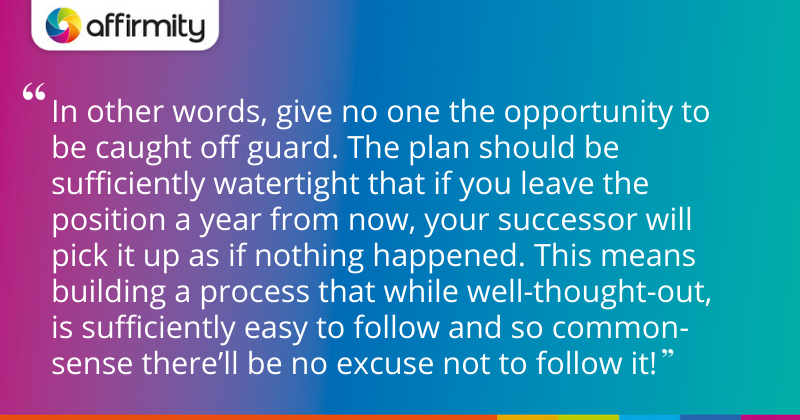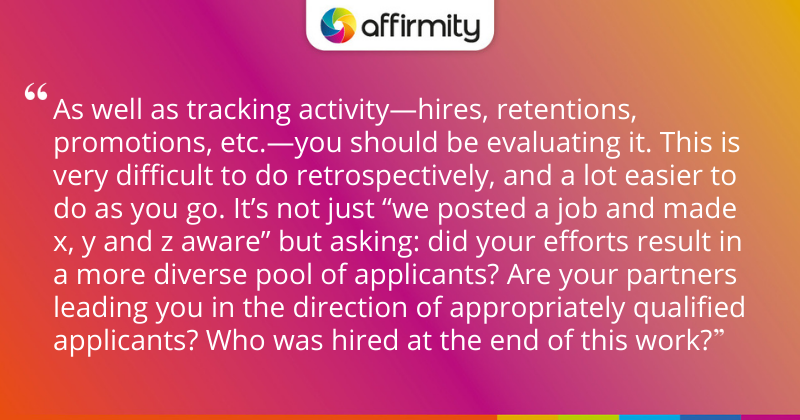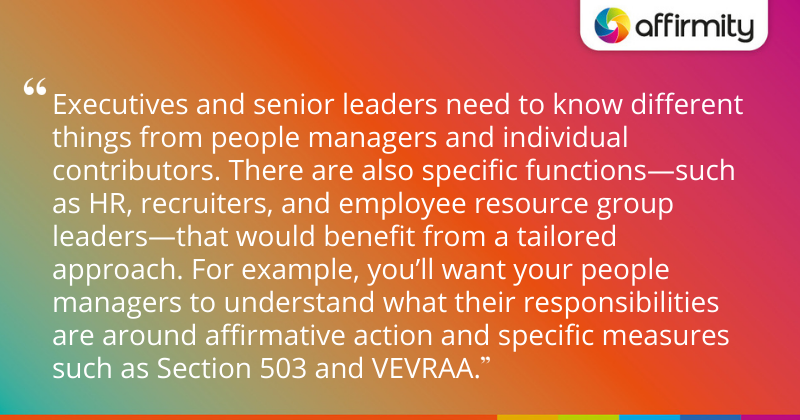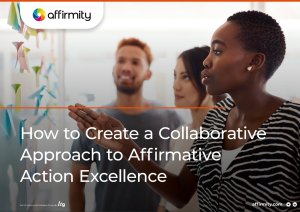What’s the best way of building engagement around your affirmative action data? Learn how to track outreach, tailor reports, and build your relationship with your learning and development team in this article aimed at everyone striving for affirmative action excellence.
Think about which reports each stakeholder needs: do they need a cross-organizational view of progress towards goals that they’re assessed against? Or do they just need to know where their department is on fair hiring relative to realistic availability data?
Beyond tailoring your reporting in this way, there are a number of key strategies to consider, especially:
- The regularity with which you provide updates
- The frequency with which you track your efforts
- The relationships you build with other departments

1) Learn How You Should Be Providing Updates Throughout the Year
Consider when and how you’re going to feed your key stakeholders all of this information: once a year isn’t enough, but you’ll also want to avoid overloading busy people with information too regularly. How often you send reports will be partly dictated by how available you are to help them interpret and use the information.
Defining a reporting cadence will take some effort to plan—what happens when, who you’re going to call upon, when updates are sent out, etc. This requires strong relationships—build them now if you don’t already have them—that work around the key parts of the year in which your data could be most useful.
For example, does your sales team go RFP crazy at a certain time of year? Get them that data at the time it’s most useful (probably immediately before that demand hits rather than during).
Enshrine this program as an ongoing and immovable part of how your organization conducts business. In other words, give no one the opportunity to be caught off guard. The plan should be sufficiently watertight that if you leave the position a year from now, your successor will pick it up as if nothing happened. This means building a process that while well-thought-out, is sufficiently easy to follow and so common-sense there’ll be no excuse not to follow it!
Of course, you don’t get any more regular than instant. Some stakeholders and some of Affirmity’s own clients prefer interactive dashboards. This approach is becoming more and more common across different areas of data in your organization thanks to business intelligence tools. A well-constructed dashboard can provide up-to-date data in a quick, concise manner without time spent searching a report. However, just as with a report, you need to be sure that your stakeholders know how to use the data, and are using it.
THE IMPORTANCE OF ACCOUNTABILITY | ‘Why Workplace Diversity Continues to Stagnate Without Accountability and Measurement’

2) How to Track Your Outreach and Good Faith Efforts
Knowing what needs to be done is one thing, doing something about it is another. But proving that you’ve done something about it? That’s the all-to-often-missed final step. If you’re audited and you can’t produce the needed proof, it’s pretty much the same as not having done anything at all!
Typical outreach efforts may include finding partner organizations that can address your hiring issues, such as various women’s groups, minority organizations, or veterans projects that work with groups traditionally underrepresented in the processes of organizations like you own.
Having a record of when and where you approach these partners and actively using their services is an obvious first step, but you can increasingly expect compliance officers to require more. As well as tracking activity—hires, retentions, promotions, etc.—you should be evaluating it.
This is very difficult to do retrospectively, and a lot easier to do as you go. It’s not just “we posted a job and made x, y and z aware” but asking: did your efforts result in a more diverse pool of applicants? Are your partners leading you in the direction of appropriately qualified applicants? Who was hired at the end of this work?
To this end, Affirmity offers its CRC management module within its online system that helps customers collect information on good faith efforts, helping to make it easier to record accommodations and provide easy access to reporting. When set up in advance, it becomes a single source of truth that can be referred to as required. However you track your good faith efforts, this is only the beginning of your response. It’s essential that you evaluate the effectiveness of those efforts and build upon them in the years to come.
DOWNLOAD OUR GOOD FAITH EFFORTS RESOURCE | ‘What Are Good Faith Efforts, Why Should You Care, and How Do You Prove They Work?’

3) Why You Should Be Building a Stronger Relationship With L&D
Ultimately, the data you collect is only meaningful if the people you deliver it to understand its implications and the measures they should be taking to correct the issues it uncovers.
This is where your allies in learning and development come in. You need to work with L&D teams to adapt their learning programs to fit your vision for AAP data use.
Just as you should be expected to adapt your reports based on the issues that need to be highlighted and the audience that needs to be addressed, L&D’s response ought to avoid one-size-fits-all measures. Executives and senior leaders need to know different things from people managers and individual contributors. There are also specific functions—such as HR, recruiters, and employee resource group leaders—that would benefit from a tailored approach.
L&D shouldn’t just be wary of “one-size-fits-all”; they also need to avoid “one-and-done”! For example, you’ll want your people managers to understand what their responsibilities are around affirmative action and specific measures such as Section 503 and VEVRAA. Delivering a single awareness session on these topics is a start, but the messaging risks being forgotten later in the year.
Ideally, you should have a full program of behavioral nudges and other messaging throughout the year, engineered to maintain understanding while not undermining busy schedules.
A CONVERSATION STARTER FROM THE BLOG | ‘One Size Doesn’t Fit All: Why Inclusion Training Must Always Be Tailored to Your Audience’
Create a Collaborative Approach to Affirmative Action Excellence—Keep Reading!
AAPs are packed with information that could be helping multiple people in your organization make better work decisions all year round—and with some tweaks to your process, you could achieve more besides. After looking at the business engagement tips above, our full guide also considers:
- A look at how to leverage data analysis methodology and reporting to bridge internal data differences
- What the pattern of compliance maintenance and oversight you’ll eventually want to settle into looks like
Download the full guide today.

